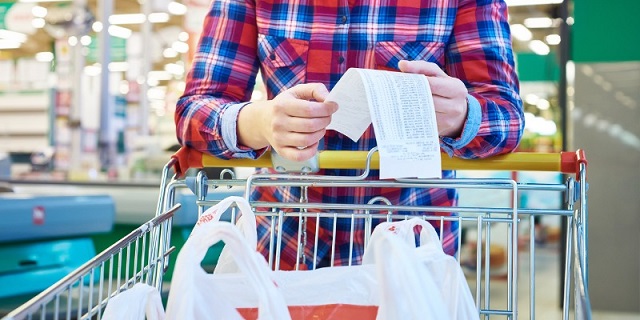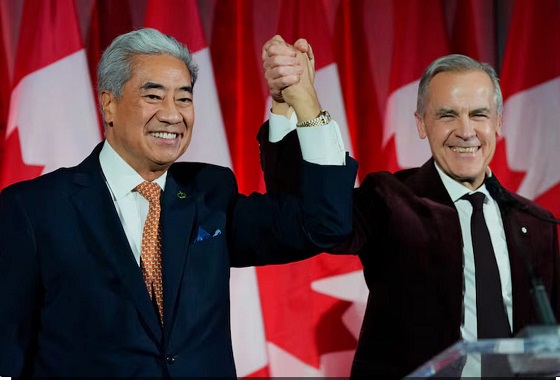Business
Ottawa’s proposed ‘food packaging’ ban will harm Canadians without helping the environment

From the Fraser Institute
The Trudeau government, which recently banned plastic bags nationwide, is now considering a ban on plastic “food packaging” in support of its ambitious “Zero Plastic Waste by 2030” goal. However, if the government bans plastic food packaging, it will impose real economic costs on Canadians and jeopardize their health, for virtually no discernible environmental benefit.
First, let’s put plastic pollution in perspective. Canada contributes an estimated 0.4 per cent of all plastic waste in the world, including just 0.02 per cent of all plastic waste in the world’s oceans. Five countries—China, the United States, Germany, Brazil and Japan—generate nearly 50 per cent of global plastic waste. And 90 per cent of the world’s ocean plastic waste comes from Asia and Africa. Even if the government achieved “Zero Plastic Waste by 2030,” the effect on global plastic waste would be undetectable.
Before these bans, Canada’s track record on managing plastic waste was outstanding, ranking 49th out of 158 countries for minimizing mismanaged plastic waste (measured on a per-person basis). The federal government acknowledges this fact in its own report where it also states that 99 per cent of the country’s plastic waste is already disposed off safely through recycling, incinerating and environmentally-friendly landfills.
And plastic bans pose real risks to human health and the environment. For example, according to a recent study in the Journal of Food Additives and Contaminants, like plastic straws, straws made from plant-based materials such as paper, wood and glass (common substitutes for plastic straws) also contain a class of chemicals known as per- and polyfluoroalkyl substances (PFAS), which can persist for thousands of years and migrate through the soil, potentially contaminating sources of drinking water. This contamination exposes both wildlife and humans to potential negative effects on the immune system, thyroid function, liver and other adverse effects that are yet to be fully understood.
In other words, we don’t fully know how plastic alternatives will affect our health and the environment.
There are other costs. For example, plastic wrapping, which could soon be banned, is instrumental in food preservation, food transit and the reduction of food waste by protecting against contamination and spoilage throughout the food supply chain. And any type of plastic packaging can increase the time food lasts from days to weeks, allowing families to cut their grocery spending. In addition, plastic is the most cost-effective among common packaging materials, so forcing the food industry to transition to pricier alternatives will raise the cost of food packaging and these added expenses will be passed on to consumers through higher food prices.
To make matters worse, eliminating plastic food packaging could also negatively impact the environment from an emission standpoint. Why? Because food production emits greenhouse gases (GHG) and the process of replacing spoiled food requires additional production, transportation and refrigeration, resulting in higher overall emissions.
Plastic substitutes such as paper are also heavier, require more energy to transport, present higher smog formation and ozone depletion potential, demand more water and energy to be produced, and ultimately result in higher greenhouse gas emissions. Researchers in Switzerland found that opting for plastic packaging for baby food, instead of glass, could reduce emissions by up to 33 per cent, mainly due to reduced weight when being transported. So, the ban on plastics can have a detrimental, rather than a beneficial impact on the environment.
Overall, the pursuit of a “zero plastic” waste goal by banning more plastic products will jeopardize the health of Canadians, negatively impact the environment, and burden the already strained finances of Canadians.
Authors:
Business
The world is no longer buying a transition to “something else” without defining what that is

From Resource Works
Even Bill Gates has shifted his stance, acknowledging that renewables alone can’t sustain a modern energy system — a reality still driving decisions in Canada.
You know the world has shifted when the New York Times, long a pulpit for hydrocarbon shame, starts publishing passages like this:
“Changes in policy matter, but the shift is also guided by the practical lessons that companies, governments and societies have learned about the difficulties in shifting from a world that runs on fossil fuels to something else.”
For years, the Times and much of the English-language press clung to a comfortable catechism: 100 per cent renewables were just around the corner, the end of hydrocarbons was preordained, and anyone who pointed to physics or economics was treated as some combination of backward, compromised or dangerous. But now the evidence has grown too big to ignore.
Across Europe, the retreat to energy realism is unmistakable. TotalEnergies is spending €5.1 billion on gas-fired plants in Britain, Italy, France, Ireland and the Netherlands because wind and solar can’t meet demand on their own. Shell is walking away from marquee offshore wind projects because the economics do not work. Italy and Greece are fast-tracking new gas development after years of prohibitions. Europe is rediscovering what modern economies require: firm, dispatchable power and secure domestic supply.
Meanwhile, Canada continues to tell itself a different story — and British Columbia most of all.
A new Fraser Institute study from Jock Finlayson and Karen Graham uses Statistics Canada’s own environmental goods and services and clean-tech accounts to quantify what Canada’s “clean economy” actually is, not what political speeches claim it could be.
The numbers are clear:
- The clean economy is 3.0–3.6 per cent of GDP.
- It accounts for about 2 per cent of employment.
- It has grown, but not faster than the economy overall.
- And its two largest components are hydroelectricity and waste management — mature legacy sectors, not shiny new clean-tech champions.
Despite $158 billion in federal “green” spending since 2014, Canada’s clean economy has not become the unstoppable engine of prosperity that policymakers have promised. Finlayson and Graham’s analysis casts serious doubt on the explosive-growth scenarios embraced by many politicians and commentators.
What’s striking is how mainstream this realism has become. Even Bill Gates, whose philanthropic footprint helped popularize much of the early clean-tech optimism, now says bluntly that the world had “no chance” of hitting its climate targets on the backs of renewables alone. His message is simple: the system is too big, the physics too hard, and the intermittency problem too unforgiving. Wind and solar will grow, but without firm power — nuclear, natural gas with carbon management, next-generation grid technologies — the transition collapses under its own weight. When the world’s most influential climate philanthropist says the story we’ve been sold isn’t technically possible, it should give policymakers pause.
And this is where the British Columbia story becomes astonishing.
It would be one thing if the result was dramatic reductions in emissions. The provincial government remains locked into the CleanBC architecture despite a record of consistently missed targets.
Since the staunchest defenders of CleanBC are not much bothered by the lack of meaningful GHG reductions, a reasonable person is left wondering whether there is some other motivation. Meanwhile, Victoria’s own numbers a couple of years ago projected an annual GDP hit of courtesy CleanBC of roughly $11 billion.
But here is the part that would make any objective analyst blink: when I recently flagged my interest in presenting my research to the CleanBC review panel, I discovered that the “reviewers” were, in fact, two of the key architects of the very program being reviewed. They were effectively asked to judge their own work.
You can imagine what they told us.
What I saw in that room was not an evidence-driven assessment of performance. It was a high-handed, fact-light defence of an ideological commitment. When we presented data showing that doctrinaire renewables-only thinking was failing both the economy and the environment, the reception was dismissive and incurious. It was the opposite of what a serious policy review looks like.
Meanwhile our hydro-based electricity system is facing historic challenges: long term droughts, soaring demand, unanswered questions about how growth will be powered especially in the crucial Northwest BC region, and continuing insistence that providers of reliable and relatively clean natural gas are to be frustrated at every turn.
Elsewhere, the price of change increasingly includes being able to explain how you were going to accomplish the things that you promise.
And yes — in some places it will take time for the tide of energy unreality to recede. But that doesn’t mean we shouldn’t be improving our systems, reducing emissions, and investing in technologies that genuinely work. It simply means we must stop pretending politics can overrule physics.
Europe has learned this lesson the hard way. Global energy companies are reorganizing around a 50-50 world of firm natural gas and renewables — the model many experts have been signalling for years. Even the New York Times now describes this shift with a note of astonishment.
British Columbia, meanwhile, remains committed to its own storyline even as the ground shifts beneath it. This isn’t about who wins the argument — it’s about government staying locked on its most basic duty: safeguarding the incomes and stability of the families who depend on a functioning energy system.
Resource Works News
Business
High-speed rail between Toronto and Quebec City a costly boondoggle for Canadian taxpayers

“It’s a good a bet that high-speed rail between Toronto and Quebec City isn’t even among the top 1,000 priorities for most Canadians.”
The Canadian Taxpayers Federation is criticizing Prime Minister Mark Carney for borrowing billions more for high-speed rail between Toronto and Quebec City.
“Canadians need help paying for basics, they don’t need another massive bill from the government for a project that only benefits one corner of the country,” said Franco Terrazzano, CTF Federal Director. “It’s a good a bet that high-speed rail between Toronto and Quebec City isn’t even among the top 1,000 priorities for most Canadians.
“High-speed rail will be another costly taxpayer boondoggle.”
The federal government announced today that the first portion of the high-speed rail line will be built between Ottawa and Montreal with constructing starting in 2029. The entire high-speed rail line is expected to go between Toronto and Quebec City.
The federal Crown corporation tasked with overseeing the project “estimated that the full line will cost between $60 billion and $90 billion, which would be funded by a mix of government money and private investment,” the Globe and Mail reported.
The government already owns a railway company, VIA Rail. The government gave VIA Rail $1.9 billion over the last five years to cover its operating losses, according to the Crown corporation’s annual report.
The federal government is borrowing about $78 billion this year. The federal debt will reach $1.35 trillion by the end of this year. Debt interest charges will cost taxpayers $55.6 billion this year, which is more than the federal government will send to the provinces in health transfers ($54.7 billion) or collect through the GST ($54.4 billion).
“The government is up to its eyeballs in debt and is already spending hundreds of millions of dollars bailing out its current train company, the last thing taxpayers need is to pay higher debt interest charges for a new government train boondoggle,” Terrazzano said. “Instead of borrowing billions more for pet projects, Carney needs to focus on making life more affordable and paying down the debt.”
-

 National2 days ago
National2 days agoCanada’s free speech record is cracking under pressure
-

 Energy2 days ago
Energy2 days agoTanker ban politics leading to a reckoning for B.C.
-

 Energy2 days ago
Energy2 days agoMeet REEF — the massive new export engine Canadians have never heard of
-

 Energy13 hours ago
Energy13 hours agoCanada’s future prosperity runs through the northwest coast
-

 Fraser Institute2 days ago
Fraser Institute2 days agoClaims about ‘unmarked graves’ don’t withstand scrutiny
-

 Business2 days ago
Business2 days agoToo nice to fight, Canada’s vulnerability in the age of authoritarian coercion
-

 Alberta2 days ago
Alberta2 days agoHere’s why city hall should save ‘blanket rezoning’ in Calgary
-

 Fly Straight - John Ivison1 day ago
Fly Straight - John Ivison1 day agoMPs who cross the floor are dishonourable members






